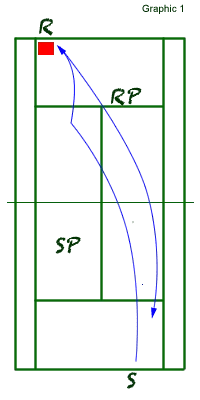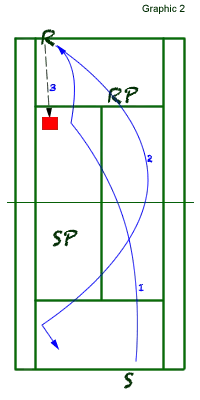Age definitely has its advantages but in tennis, it comes also with certain limitations.
How can seniors enjoy playing tennis by using less energy through good court positioning and smart tactics – this is exactly what we’ll analyze in the following article.
– If you prefer to serve and volley, from a tactical point of view, the serve must be at a slower pace to give you more time to get inside or close to the service line for the first volley or half-volley.
But your slower serve should not be easy to return by opponents therefore I suggest you add as much spin to it as you can. Your returning opponent should be concerned with controlling and getting the ball back in play as opposed to attacking.
So your key element when serving will be… spin.
Kick serve (top spin) could be a challenge for a senior player because it requires a more flexible body that’s why I would recommend the slice (side spin) for both, first and second, serves.
– If you don’t serve and volley (stay back at the baseline), focusing on getting the first serve in should be your top priority. That’s because on the first serve most of the returners will stay back expecting a faster ball; when returning second serves your opponent will step inside the baseline and expect a slower delivery. That is the reason I always suggest that the second serve should have plenty of spin to avoid an easy sitter for the returner. Slice, again, for seniors would be my classic suggestion.
– When returning the first serve, most of the players take a defensive position. This means they will stay further back at least for the first shot.
After that, court positioning is key…
Once you manage to return the first serve, I recommend that you take up a spot that is just inside the baseline and next to the singles sideline. By doing that you’ll be closer to the eventual drop shots, wide balls, and you’ll also have plenty of time to back up if the ball comes back deep (see graphic 1, red spot).

– When returning the second serve, you can step inside the baseline as you wait for it and take the ball early. Use a continental grip to slice your return and try to keep it low and away from the opposing net player. Another option would be a lob over the opposing net player which will give you time to move up closer to the net; but not too close considering that most of the time the lob will be returned with another lob. Position yourself just inside the service line if you attack behind a lob (see graphic 2 below).

In either of the two cases (slice or lob return), you can and should move up to the net; most of the points in doubles can be easily won at the net as opposed to playing from the baseline.
– If you intend to slice your return, do prepare with the racquet face higher than the eventual point of contact. That will allow you to apply more pace and spin on the ball which makes it harder for the net opponent attempting to poach.
– If you want to return using topspin, do test the net player once in a while just by hitting at him (or down the line). That will make him think twice before leaving his spot and pursuing the poach.
– If you choose the lob return, aiming towards the singles sideline will be an excellent choice to open the court for you and your opponent.